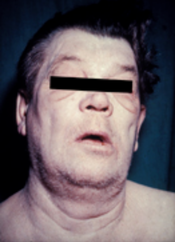Myxedema
| Myxedema | |
|---|---|
| Other names | Myxoedema |
mucopolysaccharide | |
| Specialty | Endocrinology |
Myxedema (
Etymology
The word myxedema originates from μύξᾰ, meaning "mucus" or "slimy substance", and οἴδημα for "swelling".
Signs and symptoms

Myxedema's characteristic physical sign is
Myxedema can also occur in the lower leg (pretibial myxedema) and behind the eyes (exophthalmos).
Severe cases, requiring hospitalization can exhibit signs of hypothermia, hypoglycemia, hypotension, respiratory depression, and coma.
Causes
Myxedema is known to occur in various forms of
Myxedema is more common in women than in men.[3]
Myxedema can occur in:
- Hyperthyroidism, associated with pretibial myxedema and exophthalmos. Pretibial myxedema can occur in 1–4% of patients with Graves' disease, a cause of hyperthyroidism.[4]
- Hypothyroidism, including Hashimoto's thyroiditis.[5]
Pathophysiology
Myxedema describes a specific form of
The increased deposition of glycosaminoglycan is not fully understood, however, two mechanisms predominate:
- Lymphocyte stimulation. In Graves' thyroid disease, lymphocytes react against the TSH receptor by inappropriately producing thyroid-stimulating immunoglobulin (IgG; type II hypersensitivity). Lymphocytes react not only against thyroid receptors, but also any tissue with cells expressing the receptor. This can lead to tissue damage and scar tissue formation, explaining the deposition of glycosaminoglycans.[8]
Diagnosis
It is often possible to diagnose myxedema on clinical grounds alone. Characteristic symptoms are weakness, cold intolerance, mental and physical slowness, dry skin, typical facies, and hoarse voice. Results of the total serum thyroxine and free thyroxine index tests usually will confirm the diagnosis.[9]
Management
Primary treatment is prompted by the administration of adequate doses of either the thyroid hormone
Myxedema coma is rare but often fatal. It occurs most often in elderly women and may be mistaken for one of the chronic debilitating diseases common to this age group.[9]
Though the exact cause of myxedema is still unclear, a wealth of research has demonstrated the importance of iodine.[10] In an important study[11] the researchers showed that in the myxedematous type of cretinism treatment with iodine normalizes thyroid function provided that the treatment is begun early in the postnatal period. If not, the prognosis remains dismal.[10]
History
Myxedema was first treated successfully in 1891 when George Redmayne Murray diagnosed a 46-year-old woman with the disease. He prescribed an extract from sheep thyroid. The patient improved significantly within a few weeks and lived another 28 years while taking the sheep thyroid extract.[12]
References
- PMID 35936163.
- ^ ISBN 978-1-4377-0314-6.)
{{cite book}}: CS1 maint: multiple names: authors list (link - ISBN 978-1451109061.
- ^ "Pretibial Myxedema". Archived from the original on 2016-03-04. Retrieved 2009-03-27.
- ^ "Hypothyroidism". The Lecturio Medical Concept Library. Retrieved 27 July 2021.
- ^ "Fibroblast". Genetics Home Reference. U.S. National Library of Medicine. 2014-05-05. Retrieved 2014-05-10.
- ^ "Fibroblasts". Retrieved 16 August 2018.
- ^ "Lymphocytes". The Lecturio Medical Concept Library. Retrieved 27 July 2021.
- ^ PMID 624451.
- ^ PMID 21760981.
- PMID 3018564.
- ^ "Eating Organs to Cure Disease". Tacomed.com. Archived from the original on 6 September 2017. Retrieved 15 June 2017.


